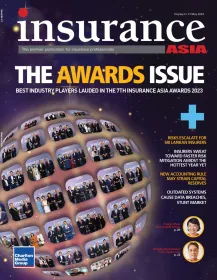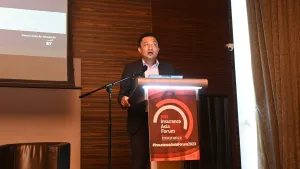Hong Kong insurers step up to seize opportunities in Greater Bay Area
By Carrie TongDespite the challenges arising from the ongoing global pandemic, Hong Kong, with its expertise and massive capital flows in the insurance market, will always be the Asian hub for multinational insurers
Carrie Tong, Manulife Hong Kong and Macau’s Chief Strategy Officer and Head of Macau Branch.
Despite the challenges arising from the ongoing global pandemic, Hong Kong, with its expertise and massive capital flows in the insurance market, will always be the Asian hub for multinational insurers. On top of that, the strong demand for insurance in Hong Kong shows no sign of abating. According to the Insurance Authority, total gross premiums of the Hong Kong insurance industry for 2021 reached HK$602.7b and new office premiums (excluding Retirement Scheme business) of long-term business were HK$166.8b, up 25% from 2020.
Furthermore, with the rapidly developing Greater Bay Area (GBA), where Hong Kong has been positioned as an international risk management centre, the city’s insurance market is set to grow ever stronger. Since the signing of the Framework Agreement on Deepening Guangdong-Hong Kong-Macao Cooperation in the Development of the Greater Bay Area in 2017, development within the GBA has accelerated, from building infrastructure to knowledge and talent exchange within cities, contributing to rocketing economic growth.
Yet, insurance penetration and density remain low in the region. The insurance penetration of nine other GBA cities is 5.5%, only one-fourth of Hong Kong (20.8%). In terms of insurance density, insurance premium per capita in Hong Kong amounts to nearly RMB70,000, more than 9 times of the nine mainland GBA cities (RMB 7,400). Demand, however, is soaring.
Insurance purchase the second reason for GBA residents to visit Hong Kong
Manulife research conducted last November to December surveyed nearly 1,600 respondents from nine GBA cities who have visited Hong Kong in the last 36 months and currently own or are interested in purchasing insurance products in Hong Kong in the next two years. Results from the survey showed that 96% are eager to visit Hong Kong when the border reopens within the first 6 months.
When asked about reasons for visiting, 70% of respondents said they plan to buy insurance products, which was the second reason behind leisure and shopping (84%). In addition, the research found that among those who are considering buying insurance, 93% tend to buy insurance in Hong Kong, which is higher than those opting for mainland China (78%), showing the considerable strength of Hong Kong’s insurance products.
Growing intent to buy insurance for spouses and children
Results further show that respondents have the desire to purchase not just one insurance product, but close to three on average. Respondents are most interested in purchasing critical illness and personal accident products, attracting 40% and 33% respectively. Additionally, respondents are interested in long-term savings insurance, universal life insurance, and investment-linked insurance. Amongst the respondents, 86% who are married plan to buy insurance for spouses, whilst 62% of parents are
looking to buy insurance for their children, showing the growing trend of protecting family members.
Pandemic drives investments in personal health
People around the globe are now more aware of critical illness and medical products since the outbreak of COVID-19. Not only are they looking for long-term health protection, but they are also seeking comprehensive and flexible insurance products that enable them to withstand the unexpected and unknown.
The mature Hong Kong insurance industry offers a wide range of comprehensive solutions designed for different needs. With the imminent resumption of cross-border travel, the insurance industry must be ready to grasp the opportunity to invest in service enhancements and product upgrades to cater to the increasing protection needs of GBA residents.












 Advertise
Advertise












